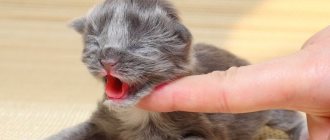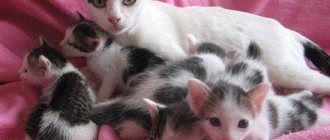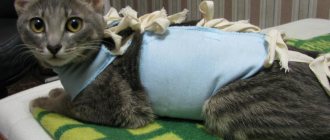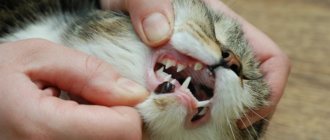What will you learn from the article?
- Preparing a place for a cat to give birth
- Signs of impending birth in a cat
- The process of giving birth in a cat
- How to help a cat give birth What not to do when giving birth to a cat
- Sterilization of a cat after birth
In order for the pregnancy to end with a successful birth of a cat, the owner of the animal must be as prepared as possible for all possible situations. After all, at a certain stage, a person becomes a comforter for a cat, an obstetrician, a cook-nutritionist, and even a builder!
In this article you will learn how kittens are born and how to help your cat in this process.
Preparing a place for a cat to give birth
Yes, you must work proactively and before the cat even thinks about which secluded place to give birth in, you simply must offer her the best option (unless, of course, you want the pet to “build a nest” on a shelf in the wardrobe or in a hard-to-reach corner under the sofa).
What can be used as a “nest” for a giving birth cat:
- exhibition cage. Some breeders offer the cat to give birth in the same cage in which the animal was previously taken to exhibitions or doctors. Let's say right away that the option is not the most suitable, since the cage will not retain internal heat, there is no privacy in it and it is not comfortable if the cat herself cannot cope with the birth of babies;
- birth box. Such a box has a hinged lid (this is a plus), an entrance for the cat (another plus) and they are convenient to place in enclosures or special rooms. You can make such a box yourself from an old bedside table;
- cube tent. One of the best options, since in such a tent it is easy to create the atmosphere the cat needs, because the tent can be closed and is quite spacious;
- but the simplest and, what’s more, the best option is a spacious cardboard box. The only things that matter here are the size and presence of ventilation holes.
Whatever version of the “nest” you choose, it must meet the basic requirements:
- The lid should open from the top. This way you will personally supervise the birth process and help if necessary;
- There must be a separate entrance for the cat. Make the entrance so that only the mother cat can use it;
- There should be a threshold at the entrance for the cat so that the kittens, as they grow up, cannot leave the “nest” on their own.
At the bottom of the “nest”, lay several layers of newspaper or oilcloth, and be sure to lay a clean diaper or sheet on top.
Then look around and try to understand what place is in your apartment:
- The calmest thing?
- Draught-free?
- Least visited by household members?
Place the box in a quiet corner and from time to time invite the pregnant cat to lie down in her new house.
Do the same if you notice that the cat is building a “nest” in a corner that you did not plan.
Mastitis.
Mastitis (inflammation of the mammary glands) in an acute purulent form sometimes develops during the first time after the onset of lactation. Inflammation is usually limited to one gland and can be caused by stagnation or production of large amounts of milk. The affected gland becomes tense, hot, painful and enlarged.
If the reason is only an overflow of milk, then, under the influence of heat and subsequent light massage, the milk comes out of the nipple, and the situation quickly normalizes. If inflammation begins, the cat begins to lose weight, becomes lethargic, febrile, and in addition to pain and swelling in the gland, redness with a noticeable accumulation of pus appears due to fluid pressure.
[custom_ads_shortcode3]
Signs of impending birth in a cat
Active movement of kittens in a cat’s stomach begins around 7-9 weeks of pregnancy. These movements can already be seen with the naked eye when the cat itself is at rest.
But how does a cat’s labor begin the day before or on the day of birth?
The cat's behavior before giving birth becomes anxious, she is restless, rushes about in search of a secluded place, breathes frequently, meows, eats poorly - these are signs that childbirth is approaching.
There are also unambiguous physiological signs of childbirth in a cat:
- Measure the cat's body temperature rectally - 24-72 hours before the onset of labor, the temperature will be 37 ° C;
- A day or two before giving birth, the cat’s genitals turn red or pink;
- Sometimes the mammary glands become engorged;
- About 5-6 hours before giving birth, the cat “hunches over” due to training contractions of the uterus;
- Within a day, the cat loses its appetite;
- But the cat drinks as usual.
If you have checked a box next to each of the above items, it means your animal is about to give birth.
Let's check if you have prepared everything for this?
What you need to pack for the birth:
- Absorbent diapers (several pieces)
- Clean cloths measuring 30 cm x 30 cm. Useful for wiping kittens. Gauze is not suitable for these purposes.
- Natural fabric towel (to cover newborn kittens)
- Hand sanitizer (alcohol, chlorhexidine)
- Baby syringe - suck out liquid from the kitten's nose
- Sterile petroleum jelly and pipette
- Latex gloves
- Zelenka
- Cotton buds
- Warmer
- Syringes
- Scissors
- Calcium gluconate – contraction stimulant
- Oxytocin – for better cleansing of the uterus after labor
- Veterinarian phone number
Mastitis.
Mastitis (inflammation of the mammary glands) in an acute purulent form sometimes develops during the first time after the onset of lactation. Inflammation is usually limited to one gland and can be caused by stagnation or production of large amounts of milk. The affected gland becomes tense, hot, painful and enlarged.
If the reason is only an overflow of milk, then, under the influence of heat and subsequent light massage, the milk comes out of the nipple, and the situation quickly normalizes. If inflammation begins, the cat begins to lose weight, becomes lethargic, febrile, and in addition to pain and swelling in the gland, redness with a noticeable accumulation of pus appears due to fluid pressure.
[custom_ads_shortcode2]
The process of giving birth in a cat
Duration of cat labor and main stages
It is impossible to predict how long a cat's labor will take. Each time, even a frequently giving birth animal spends different amounts of time on this.
The average duration of labor is from 2 to 6 hours.
It is normal if a cat gives birth for more than 6 hours, or even 24 or 36 hours.
The process of giving birth to kittens takes place in three stages.
Stage 1
In the first stage, the uterus contracts and the cervix opens. Outwardly, this manifests itself in the appearance of discharge from the cat’s vagina. This is the so-called mucous plug, which throughout pregnancy separated the uterus from the vagina, but at this stage its function has exhausted itself. Visually, the large belly goes down. Vomiting may occur, do not be alarmed by this.
Stage 2
At the second stage, contractions become more frequent, the cervix dilates completely, and the first kitten begins to move along the birth canal.
Outwardly, this manifests itself in the fact that the cat strains to push the newborn out.
The interval between the birth of kittens is from 5 minutes to an hour.
The cat cleans the newborn kitten from the bubble and licks it until the next kitten appears.
Stage 3
Delivery of the placenta. The cat itself chews the umbilical cord and often eats the placenta. The owner’s task is to monitor whether the placenta has been delivered and whether the number of kittens coincides with the number of placentas delivered. Placenta remaining in the birth canal leads to complications.
IMPORTANT!
There may be a long gap between the appearance of kittens. This is the so-called interrupted birth, in which the rest period is a day or more. If you suspect your cat has had an interrupted birth, you should contact your veterinarian.
Induction of labor
If labor weakens or stops, you should not panic in advance - most likely, it will resume after some time. The physiological characteristics of cats are that after the birth of one or two cubs, labor may subside and resume only after a few hours (sometimes the interval is 12-24 hours). To speed up the process, you can gently massage the mother's belly and nipples.
Oxytocin and other labor inducing agents should be used cautiously
Attention: Oxytocin should only be used as a last resort, after consulting with a veterinarian - improper use of the drug can lead to the death of kittens and the cat itself.
How to help your cat give birth
During childbirth, the cat breathes heavily, moans, meows... As we have already mentioned, in most cases, only one thing is required from the owner during childbirth - to console and reassure. But there are situations when human intervention can save the life of both newborns and the cat itself. And here it is important to know what to do in emergency situations.
So, the kitten was born, but the amniotic sac did not burst on its own and the cat did not rupture it.
What to do, how to help a cat during childbirth?
- burst the bubble under the kitten's nose;
- Take the baby in your palm, press it a little with your fingers and shake it. If there is no reaction, use a small syringe to remove liquid from the respiratory tract;
- rub with a clean cloth;
- shake again;
- Offer the kitten to the cat so that she can lick the baby.
If the kitten does not show signs of life, this does not mean that it is stillborn. Hold the kitten upside down (not by the paws!) - this stimulates breathing.
Try to place the baby who had to be resuscitated in this way more often near the mother cat.
What to do if the kitten gets stuck while pushing? To independently deliver a cat and extract a kitten:
- put on rubber gloves and lubricate the cat’s vagina with Vaseline;
- take a clean cloth and, grasping the kitten’s body, gently pull it down, rocking the kitten from side to side. You can't pull on limbs!
What to do if the cat does not have milk for kittens or she abandons them.
What not to do when giving birth to a cat
- human antiseptics cannot be used;
- Do not pull kittens by the paws;
- the cat should not be allowed to eat more than two placentas;
- do not hold newborn kittens in your arms during the first hours;
- do not turn on bright lights in the room where the babies now live (this can lead to cataracts);
- Don’t panic – everything will go according to plan if you’ve prepared thoroughly!
Causes of the problem: what most often provokes it?
Childbirth in cats ends with the separation of the placenta (placenta, baby's place). When no complications are observed, he comes out immediately after the kitten or after a short period. Each baby has its own placenta, so the number of newborns must correspond to the number of placenta released. However, there are situations when the baby's place does not come out during childbirth in cats. The following factors can trigger the problem:
- lack of normal uterine tone;
- premature closure of the organ neck;
- large fruits or a large number of them, as a result of which the uterus is stretched;
- the female’s body weight is too large or small;
- incorrect and unbalanced diet during pregnancy.
Return to contents.
[custom_ads_shortcode2]
When should you contact a veterinarian?
As for placentas, they should all come out within 12 hours after the end of labor. If there are fewer placentas delivered than kittens were born, then it is urgent to show the cat to a specialist.
Below is a list of situations when you and your cat will also need the help of a veterinarian:
- Premature birth. The average pregnancy rate is 51-71 days. If labor starts earlier, you should see a doctor!
- Sometimes it becomes necessary to artificially induce labor. But in each specific case, only the doctor decides HOW to do this;
- Attempts last half an hour or more, but labor never occurs;
- Vivid bleeding indicates tissue rupture. Only a doctor can solve the problem;
- If the day after giving birth the cat experiences vaginal discharge with a particularly unpleasant odor;
- If a lactating cat then develops a fever;
- If the mammary glands are inflamed and hardened;
- If the kittens are cold and hard to the touch.
Video
What is afterbirth, the causes of problems with it
In order to competently provide assistance during childbirth, in time to suspect the retention of the placenta in the uterus, it is necessary to understand what a cat’s placenta is. Normally, the birth act in all animals ends with the separation of the membranes, the so-called afterbirth (placenta, baby's place). During intrauterine development, the placental membranes provide a physiological connection between the mother’s body and the developing fetus. With their help, the supply of nutrients and oxygen occurs, as well as the utilization of metabolic products of growing fruits.
The placenta comes out with the kitten. During childbirth without complications after the birth of the kitten, its placenta comes out either after it or after a few minutes. Each newborn has its own placenta, so the number of kittens born must correspond to the number of membranes released. Owners often wonder how long it takes for a cat to lose its placenta. Veterinary experts consider it normal for the membranes to rupture within 3 hours after birth.
There are several reasons why a child’s place is detained:
- uterine atony (insufficient contractile function);
- premature cervical closure;
- inflammatory processes of the reproductive system (endometrium and placenta);
- accumulation of fluid in the amniotic membranes;
- stretching of the uterine tissue during the birth of large or large numbers of fetuses.
Predisposing factors are:
- overweight (obesity);
- lack of physical activity during pregnancy;
To prevent placenta retention, the owner of a furry pet should pay attention to keeping the cat during pregnancy. Physical inactivity, weight problems, lack of complete proteins, vitamins and minerals in the diet can lead to the development of complications in the form of delayed childbirth.
[custom_ads_shortcode1]
Caring for a cat after birth
It is important to remember that in the first days after a normal birth, neither the cat nor the kittens in the nest should be disturbed. The task of a loving owner is to watch and feed.
What should you watch for?
Behind the discharge. For 10 days after giving birth, normal discharge may be expelled from your cat's vagina. The contracting uterus rejects suckers - fragments of organic matter. They are not abundant, smearing, reddish or brownish. In order to control bleeding after childbirth (the color of the lochia and its quantity), place a light-colored sheet in the nest and change it regularly.
Maintaining cleanliness in the birth box is also on the owner’s conscience. Kittens and mother cat should be comfortable, dry and warm! It is recommended to change the bedding when the cat leaves the house to do its business (to the toilet or to the kitchen). Quickly transfer the kittens to another box (but not on the floor!) and change the sheet. If the cat comes running back in a panic, calm it down and show it that everything is fine with the babies.
Behind the peristalsis of a cat. For the first days after giving birth, she does not go to the toilet, because she instinctively emptied her bowels well before the babies appeared. But if hard stool does not appear by the 4-5th day after birth, you need to help your pet and give her those foods that usually work as a laxative.
You cannot bathe a cat after giving birth! Even if the cat has soiled itself after giving birth, believe me, several hours will pass and not a trace will remain of these marks - the cat will definitely clean itself up.
Threat to the animal
The owner of the animal must understand the threat this pathology of the birth process poses. Retention of the placenta in the birth canal can be complete or partial. If the child's seat has not separated at all, then we are talking about complete detention.
If the membranes do not come out completely, then this pathology is called partial retention of the placenta. In both cases, there is a threat of inflammation.
The open birth canal quickly becomes infected with microbes. In this case, putrefactive inflammation of the uterus occurs, since the cervix is not yet closed. An inflamed mother's womb is a good breeding ground for the development of bacteria, which easily penetrate the bloodstream and spread throughout the body, causing septicemia (blood poisoning). The animal becomes severely intoxicated.
Untimely assistance can lead not only to the loss of the ability to reproduce, but also to death. Therefore, owners must be present during the birth and monitor the expulsion of the pet’s placenta.
[custom_ads_shortcode2]
What to feed a cat after giving birth
Do not be alarmed if your cat refuses to eat within 24 hours after giving birth. Don't let loose stool in your cat's litter box upset you. The cat's appetite was deprived of the eaten placenta, which also caused indigestion. Don’t wait for the cat to go to the bowl on its own; place a bowl of water near the family house. Give your pet plenty of water (not milk) and wait for his appetite to appear.
The cat will be interested in food on the second or even third day after birth. A cat that has given birth needs to be fed frequently - up to 8 meals per day.
In principle, there is no need to change the animal’s diet, but you need to strengthen it a little:
- calcium Lack of calcium sometimes leads to milk fever and convulsions, so your pet should have cottage cheese in sufficient quantities and quail eggs on the menu;
- phosphates. Buy bone meal and add it little by little to your cat's food;
- vitamins. There is no need to reinvent the wheel; stores have long sold vitamin complexes for nursing cats.
Read more about feeding a nursing cat.
Why is it dangerous?
For an animal, such a pathology can result in infection entering the bloodstream.
Detention of the birth place can be partial or complete. If we talk about the latter, the afterbirth does not separate completely. A partial delay is observed when the shells do not come out completely.
Both of these conditions are fraught with the rapid onset of inflammatory processes, since the open birth canal infects pathogenic microorganisms. As a result, purulent inflammation of the uterus is often observed. Pathogenic bacteria enter the bloodstream, spreading throughout the body and causing blood poisoning.
Return to contents.
[custom_ads_shortcode3]
When do they start?
Note that harbingers of contractions may appear about a week before the “true” birth, but they are still not direct attempts. Rather, it is a “rehearsal” for the body, as well as a time when the organs of the reproductive system begin to prepare for the processes of childbirth. During this same period, the body’s mitochondria accumulate energy, which will be required during intense contractions of the muscular layer of the uterus. This phenomenon is also called "false contractions" . A distinctive feature of the latter is its early appearance - immediately before the due date there are still a few days left (up to a week and a half). They start quickly and end just as quickly. Note that at this time the cat does not experience any pain or other unpleasant sensations. This explains the relatively calm behavior of the animal.
Contractions begin during the first, preparatory stage of the birth process.
These are training attempts with which the animal’s body “tests” itself, checking the readiness of systems and organs for the birth of offspring. As in the case of false attempts, their training variety is characterized by a quick, sudden appearance, but such contractions still last longer. The cat becomes restless, can run around the house and meow heart-rendingly, looking for a place that is most suitable for the birth of kittens. All this happens periodically, the rest of the time the pet’s behavior is no different from normal.
How can you tell if your cat is having contractions indicating an imminent birth? The immediate onset of labor is indicated by a combination of other signs: first, the remnants of the mucus plug leave, and soon after this, the discharge of fetal fluid may begin. Considering that the mucus plug may well come off three or five days before the actual start of labor, a really reliable sign is strong and prolonged contractions, accompanied by the release of large volumes of amniotic fluid.











